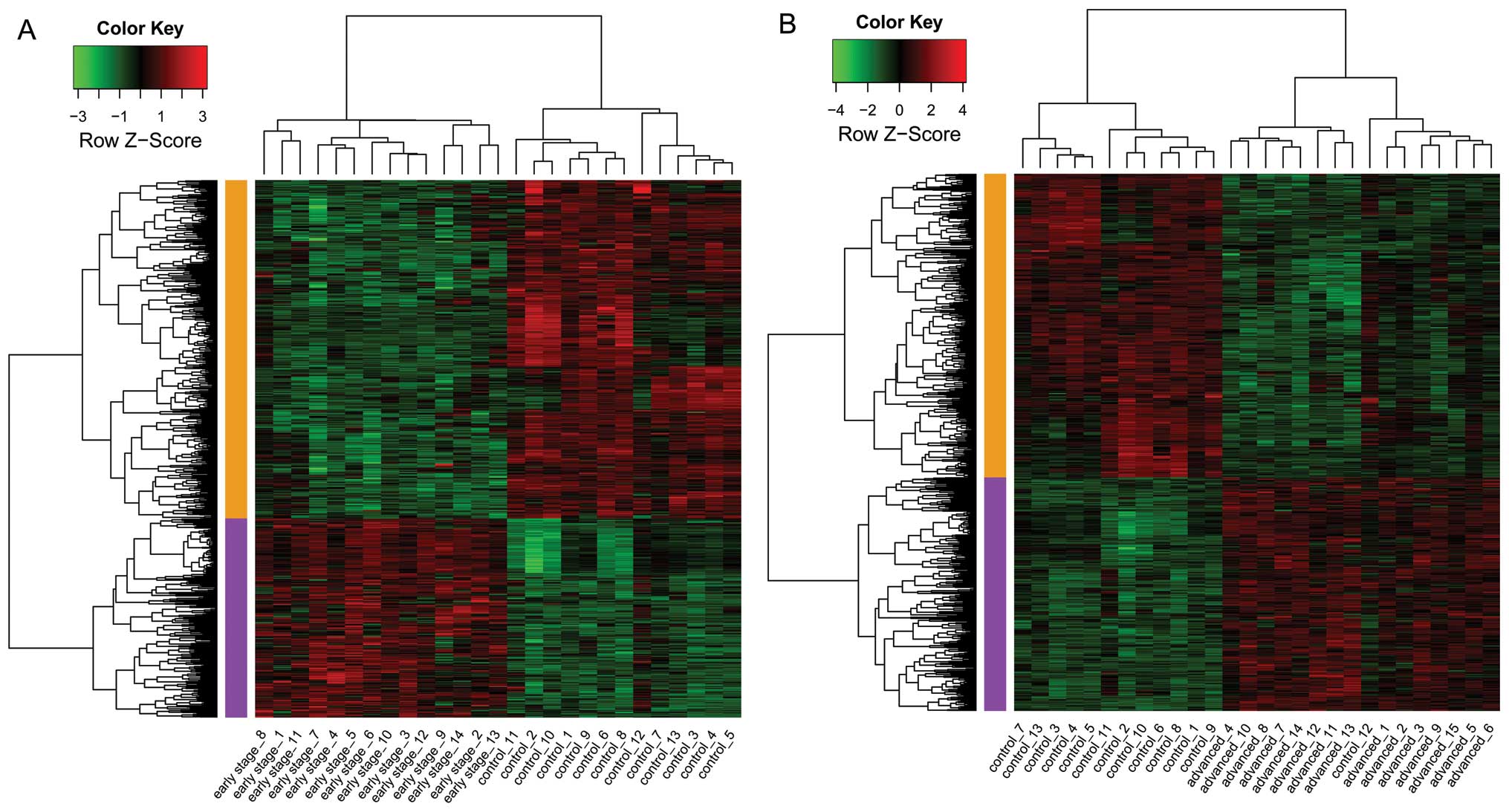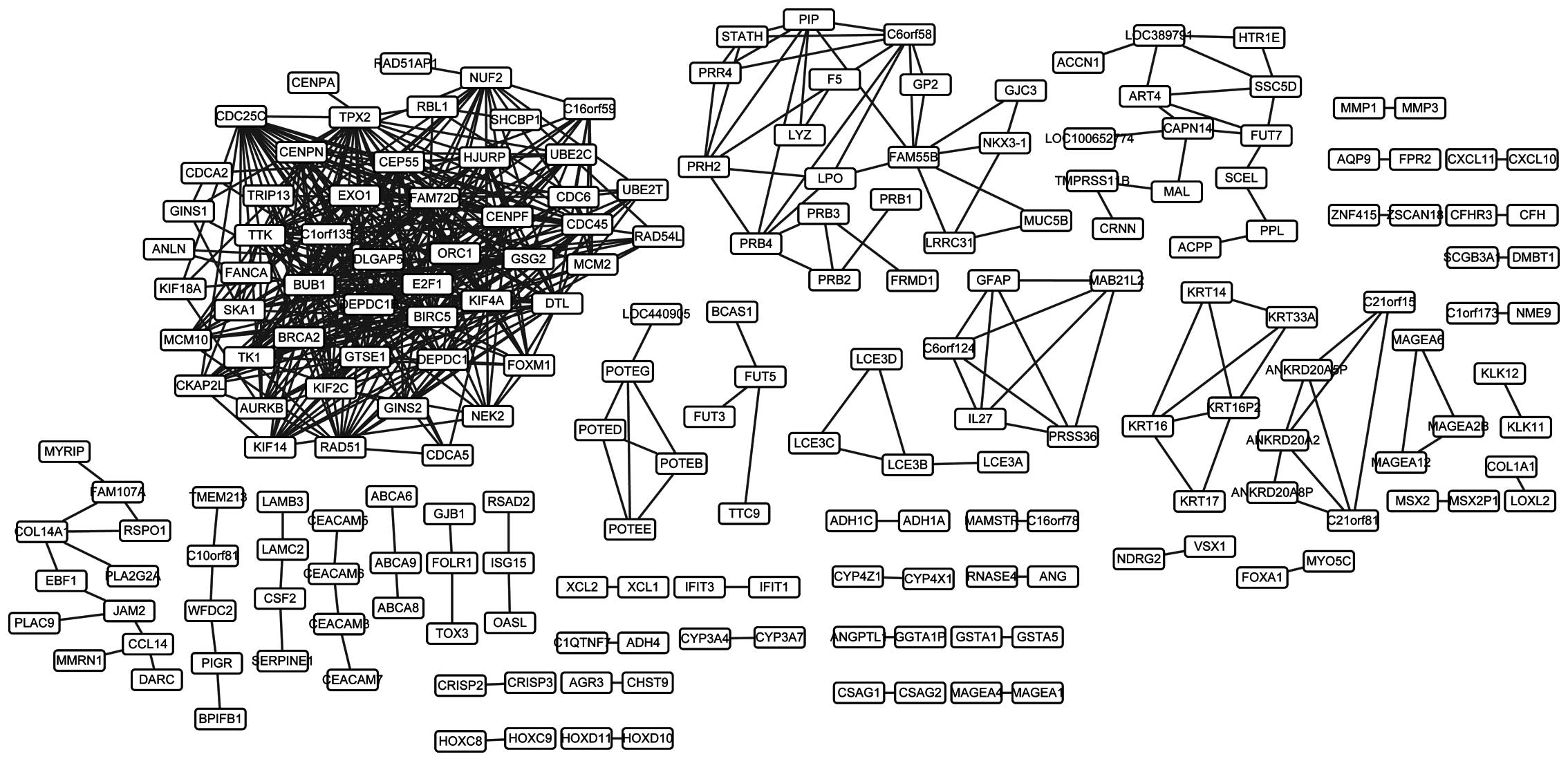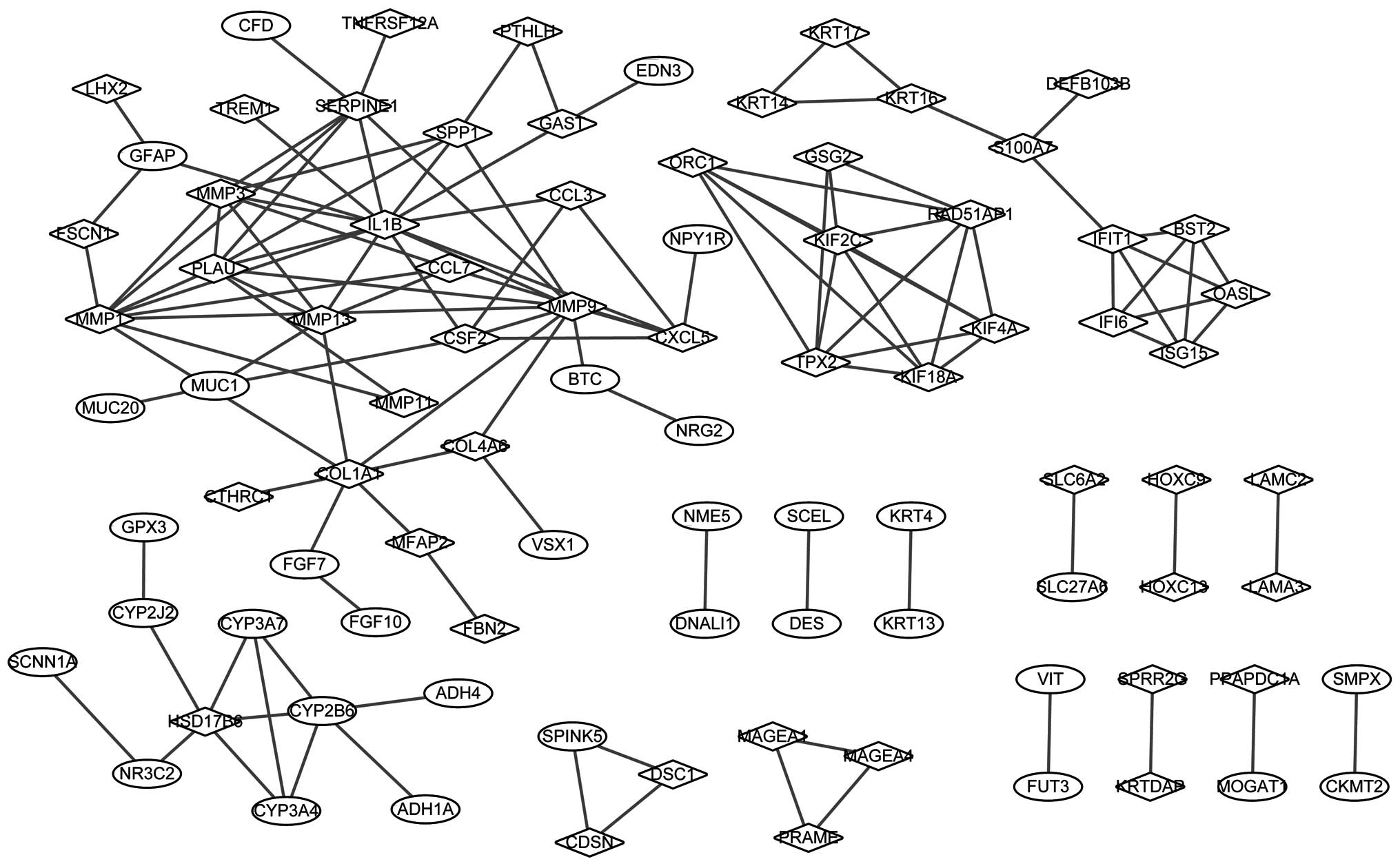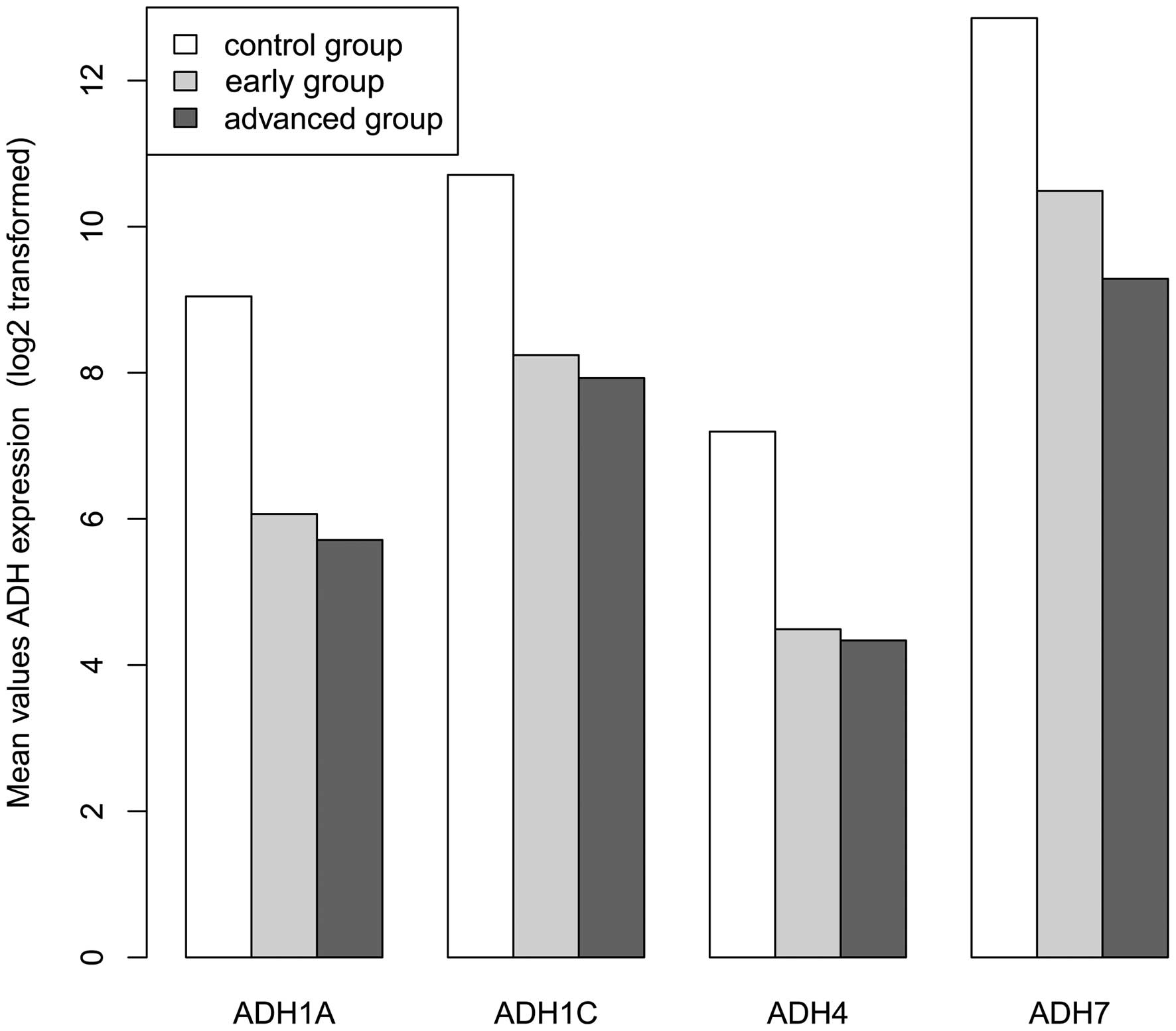|
1
|
Hui AB, Lenarduzzi M, Krushel T, Waldron
L, Pintilie M, Shi W, Perez-Ordonez B, Jurisica I, O'Sullivan B,
Waldron J, et al: Comprehensive MicroRNA profiling for head and
neck squamous cell carcinomas. Clin Cancer Res. 16:1129–1139. 2010.
View Article : Google Scholar : PubMed/NCBI
|
|
2
|
Wang W, Lin P, Han C, Cai W, Zhao X and
Sun B: Vasculogenic mimicry contributes to lymph node metastasis of
laryngeal squamous cell carcinoma. J Exp Clin Cancer Res.
29:602010. View Article : Google Scholar : PubMed/NCBI
|
|
3
|
Zhang S-Y, Lu Z-M, Luo X-N, Chen LS, Ge
PJ, Song XH, Chen SH and Wu YL: Retrospective analysis of
prognostic factors in 205 patients with laryngeal squamous cell
carcinoma who underwent surgical treatment. PLoS One. 8:e601572013.
View Article : Google Scholar : PubMed/NCBI
|
|
4
|
Li D, Feng J, Wu T, Wang Y, Sun Y, Ren J
and Liu M: Long intergenic noncoding RNA HOTAIR is overexpressed
and regulates PTEN methylation in laryngeal squamous cell
carcinoma. Am J Pathol. 182:64–70. 2013. View Article : Google Scholar
|
|
5
|
Karatas OF, Yuceturk B, Suer I, Yilmaz M,
Cansiz H, Solak M, Ittmann M and Ozen M: The role of miR-145 in
Human Laryngeal Squamous Cell Carcinoma. Head Neck n/a. 2014.
|
|
6
|
Rudolph E, Dyckhoff G, Becher H, Dietz A
and Ramroth H: Effects of tumour stage, comorbidity and therapy on
survival of laryngeal cancer patients: A systematic review and a
meta-analysis. Eur Arch Otorhinolaryngol. 268:165–179. 2011.
View Article : Google Scholar
|
|
7
|
Liu WW, Zeng ZY, Wu QL, Hou JH and Chen
YY: Overexpression of MMP-2 in laryngeal squamous cell carcinoma: A
potential indicator for poor prognosis. Otolaryngol Head Neck Surg.
132:395–400. 2005. View Article : Google Scholar : PubMed/NCBI
|
|
8
|
Shi Y, Gong H-L, Zhou L, Tian J and Wang
Y: CD24: A novel cancer biomarker in laryngeal squamous cell
carcinoma. ORL J Otorhinolaryngol Relat Spec. 74:78–85. 2012.
View Article : Google Scholar : PubMed/NCBI
|
|
9
|
Chen K, Cornejo KM, Ye W, Wu Q, Liang J
and Jiang Z: Oncofetal protein IMP3: A new diagnostic biomarker for
laryngeal carcinoma. Hum Pathol. 44:2126–2131. 2013. View Article : Google Scholar : PubMed/NCBI
|
|
10
|
Geomela P-A, Kontos CK, Yiotakis I,
Fragoulis EG and Scorilas A: L-DOPA decarboxylase mRNA expression
is associated with tumor stage and size in head and neck squamous
cell carcinoma: A retrospective cohort study. BMC Cancer.
12:4842012. View Article : Google Scholar : PubMed/NCBI
|
|
11
|
Saglam O, Shah V and Worsham MJ: Molecular
differentiation of early and late stage laryngeal squamous cell
carcinoma: An exploratory analysis. Diagn Mol Pathol. 16:218–221.
2007. View Article : Google Scholar : PubMed/NCBI
|
|
12
|
Plaça JR, Pinheiro DG, Panepucci RA, et
al: Gene expression analysis of laryngeal squamous cell carcinoma.
Genomics Data. 5:9–12. 2015. View Article : Google Scholar
|
|
13
|
Smyth GK: Limma: Linear models for
microarray data. Bioinformatics and Computational Biology Solutions
using R and Bioconductor. Springer; New York, NY: pp. 397–420.
2005, View Article : Google Scholar
|
|
14
|
Blake JA, Dolan M, Drabkin H, Hill DP, Li
N, Sitnikov D, Bridges S, Burgess S, Buza T, McCarthy F, et al Gene
Ontology Consortium: Gene Ontology annotations and resources.
Nucleic Acids Res. 41(D1): D530–D535. 2013. View Article : Google Scholar
|
|
15
|
Kanehisa M, Goto S, Sato Y, Furumichi M
and Tanabe M: KEGG for integration and interpretation of
large-scale molecular data sets. Nucleic Acids Res. 40:D109–D114.
2012. View Article : Google Scholar :
|
|
16
|
Dennis G Jr, Sherman BT, Hosack DA, Yang
J, Gao W, Lane HC and Lempicki RA: DAVID: Database for annotation,
visualization, and integrated discovery. Genome Biol. 4:32003.
View Article : Google Scholar
|
|
17
|
Matys V, Kel-Margoulis OV, Fricke E,
Liebich I, Land S, Barre-Dirrie A, Reuter I, Chekmenev D, Krull M,
Hornischer K, et al: TRANSFAC and its module TRANSCompel:
Transcriptional gene regulation in eukaryotes. Nucleic Acids Res.
34:D108–D110. 2006. View Article : Google Scholar
|
|
18
|
Zhao M, Sun J and Zhao Z: TSGene: A web
resource for tumor suppressor genes. Nucleic Acids Res.
41:D970–D976. 2013. View Article : Google Scholar :
|
|
19
|
Szklarczyk D, Franceschini A, Kuhn M,
Simonovic M, Roth A, Minguez P, Doerks T, Stark M, Muller J, Bork
P, et al: The STRING database in 2011: Functional interaction
networks of proteins, globally integrated and scored. Nucleic Acids
Res. 39:D561–D568. 2011. View Article : Google Scholar :
|
|
20
|
Kohl M, Wiese S and Warscheid B:
Cytoscape: Software for Visualization and Analysis of Biological
Networks. Data Mining in Proteomics. Springer; pp. 291–303.
2011
|
|
21
|
Mattingly C, Rosenstein M, Colby G,
Forrest J Jr and Boyer J: The Comparative Toxicogenomics Database
(CTD): A resource for comparative toxicological studies. J Exp Zool
A Comp Exp Biol. 305:689–692. 2006. View Article : Google Scholar : PubMed/NCBI
|
|
22
|
Johnson VL, Scott MI, Holt SV, Hussein D
and Taylor SS: Bub1 is required for kinetochore localization of
BubR1, Cenp-E, Cenp-F and Mad2, and chromosome congression. J Cell
Sci. 117:1577–1589. 2004. View Article : Google Scholar : PubMed/NCBI
|
|
23
|
Ma HF, Guo X and Li XY: Expression and
Interaction between STK15 and BUBR1 in Human Laryngeal Squamous
Cell Carcinoma. J China Med Univ. 7:0172011.
|
|
24
|
Li Z, Chen Y, Yan F, Zhang Q, Zhou J and
Yang J: The expression of BUB1 in laryngeal squamous cell carcinoma
and its clinical significance. Lin Chung Er Bi Yan Hou Tou Jing Wai
Ke Za Zhi. 27:1184–1187. 2013.In Chinese.
|
|
25
|
Liu Y, Sun W, Zhang K, Zheng H, Ma Y, Lin
D, Zhang X, Feng L, Lei W, Zhang Z, et al: Identification of genes
differentially expressed in human primary lung squamous cell
carcinoma. Lung Cancer. 56:307–317. 2007. View Article : Google Scholar : PubMed/NCBI
|
|
26
|
Dou Z, Ding X, Zereshki A, Zhang Y, Zhang
J, Wang F, Sun J, Huang H and Yao X: TTK kinase is essential for
the centrosomal localization of TACC2. FEBS Lett. 572:51–56. 2004.
View Article : Google Scholar : PubMed/NCBI
|
|
27
|
Ahmed AA, Lu Z, Jennings NB,
Etemadmoghadam D, Capalbo L, Jacamo RO, Barbosa-Morais N, Le XF,
Vivas-Mejia P, Lopez-Berestein G, et al Australian Ovarian Cancer
Study Group: SIK2 is a centrosome kinase required for bipolar
mitotic spindle formation that provides a potential target for
therapy in ovarian cancer. Cancer Cell. 18:109–121. 2010.
View Article : Google Scholar : PubMed/NCBI
|
|
28
|
Sen S, Ateeq B, Sharma H, Datta P, Gupta
SD, Bal S, Kumar A and Singh N: Identification of differentially
expressed genes in human lung squamous cell carcinoma in Asian
Indians using suppression subtractive hybridization. Clin Cancer
Res. 12:A71. 2006.
|
|
29
|
Pi J-T, Lin Y, Quan Q, Chen LL, Jiang LZ,
Chi W and Chen HY: Overexpression of UHRF1 is significantly
associated with poor prognosis in laryngeal squamous cell
carcinoma. Med Oncol. 30:6132013. View Article : Google Scholar : PubMed/NCBI
|
|
30
|
Fabbro M, Zhou B-B, Takahashi M, et al:
Cdk1/Erk2- and Plk1-dependent phosphorylation of a centrosome
protein, Cep55, is required for its recruitment to midbody and
cytokinesis. Dev Cell. 9:477–488. 2005. View Article : Google Scholar : PubMed/NCBI
|
|
31
|
Waseem A, Ali M, Odell EW, Fortune F and
Teh MT: Downstream targets of FOXM1: CEP55 and HELLS are cancer
progression markers of head and neck squamous cell carcinoma. Oral
Oncol. 46:536–542. 2010. View Article : Google Scholar : PubMed/NCBI
|
|
32
|
Sun X, Liu B, Ji W, Ma X, Wang X and Gu H:
The role of HOXA9 in human laryngeal squamous cell carcinoma. Oncol
Res. 20:467–472. 2013. View Article : Google Scholar : PubMed/NCBI
|
|
33
|
Krecicki T, Fraczek M, Jelen M, Podhorska
M, Szkudlarek T and Zatonski T: Expression of collagenase-1
(MMP-1), collagenase-3 (MMP-13) and tissue inhibitor of matrix
metalloproteinase-1 (TIMP-1) in laryngeal squamous cell carcinomas.
Eur Arch Otorhinolaryngol. 260:494–497. 2003. View Article : Google Scholar : PubMed/NCBI
|
|
34
|
Cao X-L, Xu R-J, Zheng YY, Liu J, Teng YS,
Li Y and Zhu J: Expression of type IV collagen,
metalloproteinase-2, metallopro-teinase-9 and tissue inhibitor of
metalloproteinase-1 in laryngeal squamous cell carcinomas. Asian
Pac J Cancer Prev. 12:3245–3249. 2011.
|
|
35
|
Qin G, Li W, Sun X, Zhu L and Chen Z:
Expression and significance of CD44v6 and MMP-9 in laryngeal
squamous cell carcinoma. Lin Chuang Er Bi Yan Hou Ke Za Zhi.
19:688–691. 2005.PubMed/NCBI
|
|
36
|
Papadas TA, Naxakis SS, Mastronikolis NS,
Stathas T, Karabekos NCh and Tsiambas E: Determination of matrix
metalloproteinase 9 (MMP-9) protein expression in laryngeal
squamous cell carcinomas based on digital image analysis. J BUON.
18:977–981. 2013.PubMed/NCBI
|
|
37
|
Nagaraj NS: Evolving 'omics' technologies
for diagnostics of head and neck cancer. Brief Funct Genomics.
8:49–59. 2009. View Article : Google Scholar
|
|
38
|
Xavier FCA, Rodini CO, Ramalho LMP,
Mantesso A and Nunes FD: WNT-5A, but not matrix metalloproteinase 3
or β-catenin protein, expression is related to early stages of lip
carcinogenesis. J Oral Pathol Med. 38:708–715. 2009. View Article : Google Scholar : PubMed/NCBI
|
|
39
|
Bogner W, Gruber S, Pinker K, Grabner G,
Stadlbauer A, Weber M, Moser E, Helbich TH and Trattnig S:
Diffusion-weighted MR for differentiation of breast lesions at 3.0
T: How does selection of diffusion protocols affect diagnosis?
Radiology. 253:341–351. 2009. View Article : Google Scholar : PubMed/NCBI
|
|
40
|
Vachani A, Nebozhyn M, Singhal S, Alila L,
Wakeam E, Muschel R, Powell CA, Gaffney P, Singh B, Brose MS, et
al: A 10-gene classifier for distinguishing head and neck squamous
cell carcinoma and lung squamous cell carcinoma. Clin Cancer Res.
13:2905–2915. 2007. View Article : Google Scholar : PubMed/NCBI
|
|
41
|
Hashibe M, McKay JD, Curado MP, Oliveira
JC, Koifman S, Koifman R, Zaridze D, Shangina O, Wünsch-Filho V,
Eluf-Neto J, et al: Multiple ADH genes are associated with upper
aerodigestive cancers. Nat Genet. 40:707–709. 2008. View Article : Google Scholar : PubMed/NCBI
|
|
42
|
Duell EJ, Sala N, Travier N, Muñoz X,
Boutron-Ruault MC, Clavel-Chapelon F, Barricarte A, Arriola L,
Navarro C, Sánchez- Cantalejo E, et al: Genetic variation in
alcohol dehydrogenase (ADH1A, ADH1B, ADH1C, ADH7) and aldehyde
dehydrogenase (ALDH2), alcohol consumption and gastric cancer risk
in the European Prospective Investigation into Cancer and Nutrition
(EPIC) cohort. Carcinogenesis. 33:361–367. 2012. View Article : Google Scholar
|
|
43
|
Chang JS, Straif K and Guha N: The role of
alcohol dehydrogenase genes in head and neck cancers: A systematic
review and meta-analysis of ADH1B and ADH1C. Mutagenesis.
27:275–286. 2012. View Article : Google Scholar
|
|
44
|
Jiang J, Loganathan J, Eliaz I, Terry C,
Sandusky GE and Sliva D: ProstaCaid inhibits tumor growth in a
xenograft model of human prostate cancer. Int J Oncol.
40:1339–1344. 2012.PubMed/NCBI
|
|
45
|
Iliopoulos D, Rotem A and Struhl K:
Inhibition of miR-193a expression by Max and RXRα activates K-Ras
and PLAU to mediate distinct aspects of cellular transformation.
Cancer Res. 71:5144–5153. 2011. View Article : Google Scholar : PubMed/NCBI
|
|
46
|
Bloch M, Ousingsawat J, Simon R, Schraml
P, Gasser TC, Mihatsch MJ, Kunzelmann K and Bubendorf L: KCNMA1
gene amplification promotes tumor cell proliferation in human
prostate cancer. Oncogene. 26:2525–2534. 2007. View Article : Google Scholar
|
|
47
|
Tomlins SA, Laxman B, Varambally S, Cao X,
Yu J, Helgeson BE, Cao Q, Prensner JR, Rubin MA, Shah RB, et al:
Role of the TMPRSS2-ERG gene fusion in prostate cancer. Neoplasia.
10:177–188. 2008. View Article : Google Scholar : PubMed/NCBI
|


















